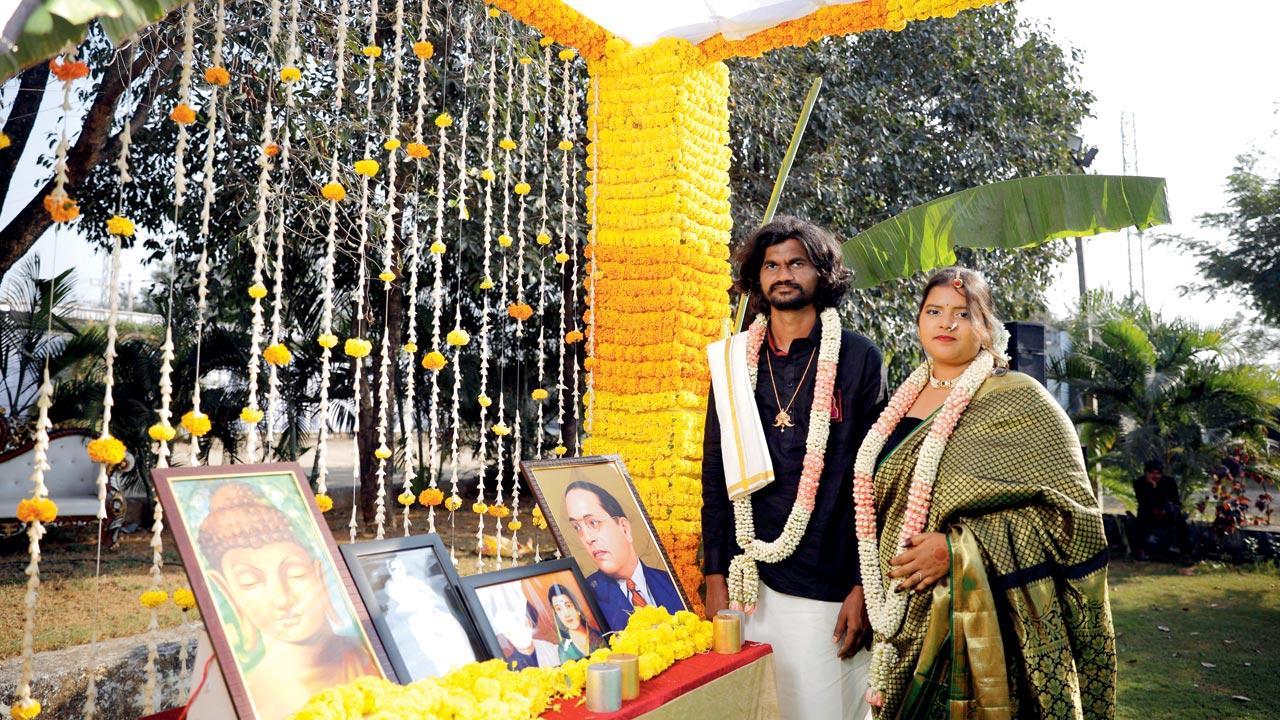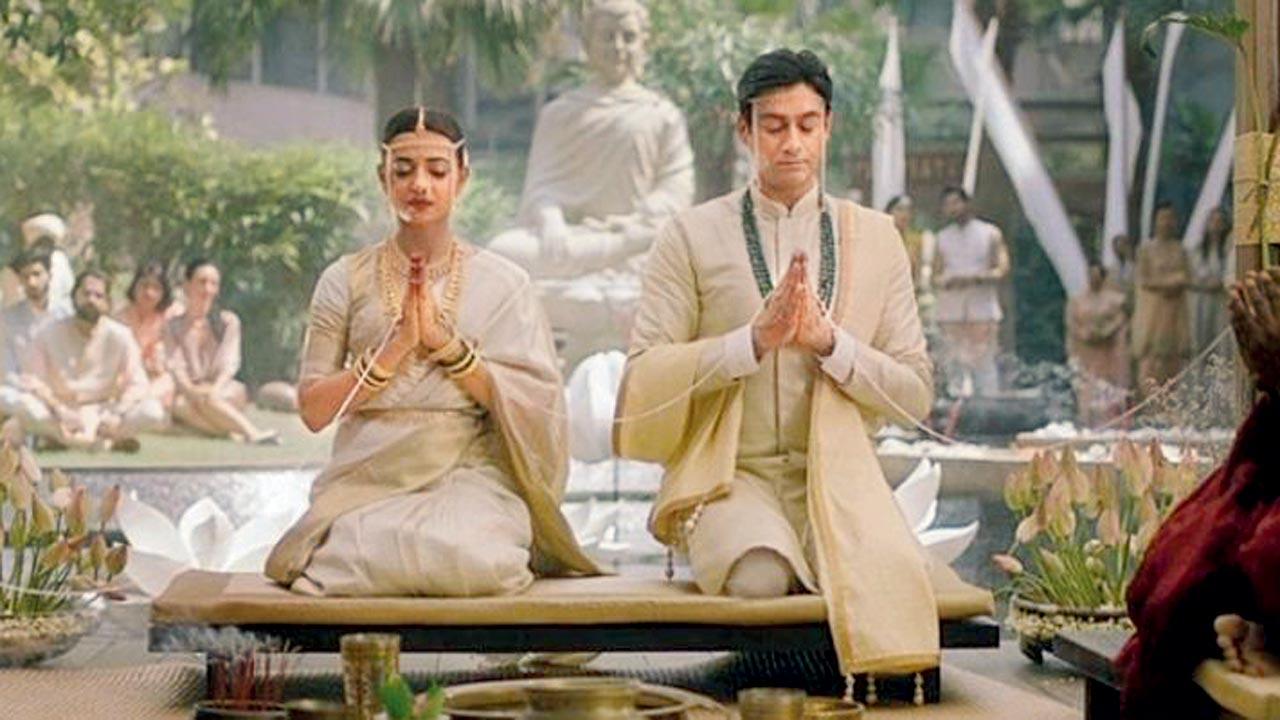While the inter-caste Buddhist wedding in the latest season of Made in Heaven has got social media chattering about non-Brahminical ceremonies, those who have long been part of the revolution explain why Dr Ambedkar and Jyotiba broke away from the institution to start new, non-religious rituals

Ambedkarite feminist Divya Kandukuri and her partner Tejas Harad chose to have a Satyashodhak wedding ceremony in January 2022, incorporating elements of the Periyar Self-Respect (Suyamariyathai) Marriage
Retired academic Govardhan Wankhede was seven years old when he witnessed an Ambedkarite Buddhist wedding in the family. Only a year earlier, on October 14, 1956, Wankhede’s relatives had been welcomed, along with lakhs of others, into the Buddhist fold by Dr Bhimrao Ramji Ambedkar. Wankhede, who originally hails from the village of Karala in the Amravati district of Maharashtra, vividly remembers the weeks following the mass conversion that took place in Nagpur.
ADVERTISEMENT
Dr Ambedkar had advised the new converts to give up their traditional occupations and impressed upon them the importance of receiving an education. Samata Sainik Dal, a social organisation formed by Dr Ambedkar, was tasked with ensuring that people followed the instructions. But many didn’t need convincing. The Mahars, who did low manual work, including disposing of dead animals, and comprised a significant number of the converted population, took his advice to heart. “Overnight, we saw a revolution,” recalls Navi Mumbai-based Wankhede, a former professor at the Tata Institute of Social Sciences. “People simply refused to do traditional work.” The revolt didn’t go down well with the upper caste.
“My village was boycotted by them. I was a child, but I still remember how for two whole months, we were denied groceries, grains and kerosene; they even refused to employ our people.” Villagers would travel several miles to work at a Muslim landlord’s farm, and get their food stock from there. “Activists had to intervene, and pursue the upper caste. Finally, they succeeded and lifted the boycott.” The following year, in 1957, the village saw its first Buddhist wedding—it was that of Wankhede’s cousin. The villagers were making an important statement.
“None of us had witnessed this kind of change before. Till yesterday, everyone was following Hindu traditions and customs, and now suddenly, we had a whole new set of rituals,” shares Wankhede, whose self-reflective autobiography, My Life: The Journey of a Dalit Sociologist, explores the social injustice and discrimination that pervaded the society he inhabited. “Babasaheb,” he says, “reinterpreted Buddhism, calling it Navayāna.” The rituals that were born out of this were not religious, he clarifies. “Buddhist rituals were adopted as a mechanism of cultural and social change and protest against Hinduism.”
 Radhika Apte, who plays Pallavi Menke, a Dalit author in web series Made in Heaven 2, challenges the casteist world view of her parents-in-law when they suggest she opt for pheras instead of a court ceremony and Buddhist rituals
Radhika Apte, who plays Pallavi Menke, a Dalit author in web series Made in Heaven 2, challenges the casteist world view of her parents-in-law when they suggest she opt for pheras instead of a court ceremony and Buddhist rituals
Wankhede followed in the footsteps of his cousin, and many others before him, when he married Radha in Akola in 1985. “[As part of the ceremony], the bride and bridegroom are expected to put on white clothes,” he says. “The marriage rituals are performed by anyone—there’s no need for a Buddhist leader or Hindu pandit [to lead the ceremony], even a woman can do so. The prayer, Buddham Sharanam Gacchami, is recited before the images of Buddha and Babasaheb, which are compulsorily displayed on the stage, with offerings of flowers and incense sticks.” The prayers are followed by the exchange of vows, and garlands. The groom has to even announce if he has asked for a dowry, or accepted it. “The ceremony is kept as simple as possible, and barely lasts 15 minutes,” says the 73-year-old professor.
“You can imagine the psychology behind the community that follows the ritual... it is taken as a protest to Hinduism, and how it has treated them over the centuries,” says Wankhede.
 Former TISS professor and sociologist Govardhan Wankhede, who married Radha in Akola in 1985 in a Buddhist ceremony, says that the ritual is seen as a mechanism of “cultural and social change” and protest against Hinduism. Pic/Sameer Markande
Former TISS professor and sociologist Govardhan Wankhede, who married Radha in Akola in 1985 in a Buddhist ceremony, says that the ritual is seen as a mechanism of “cultural and social change” and protest against Hinduism. Pic/Sameer Markande
Last week, when the second season of Made in Heaven released on Amazon Prime, the Neeraj Ghaywan-directed episode drew a lot of attention. While the episode is currently mired in controversy over “identity theft” accusations by Dalit author Yashica Dutt, its portrayal of Dalit bride Pallavi Menke, played by Radhika Apte, made all the right noises. For many, this was the first time that they had seen a Buddhist wedding on screen. “Or even an acknowledgement that Dalit customs are not the same as Savarna wedding rituals,” as author Annie Zaidi said on Twitter, adding, “It takes so much cultural obfuscation to keep certain ideas not only ‘mainstream’, but also the only stream.”
Sahil Valmiki, co-founder and editor, Dalit Desk, admits that seeing an Ambedkarite Buddhist wedding on a mainstream entertainment platform was path-breaking in itself. “Our history, narratives, accomplishments, and heritage have long been obscured and marginalised,” he says. “Cinema, dominated primarily by the upper castes, has consistently marginalised the voices of the Scheduled Castes and Scheduled Tribes. Consequently, our country’s marginalised masses have been exposed to the norms depicted by a privileged minority for decades.” He feels that the current landscape, which is witnessing a significant transformation with directors and writers hailing from the Dalit community, has played a role in “challenging this status quo by bringing to light our personal stories, victories, and culture”. “This shift is of paramount importance, as it dismantles stereotypes and prejudices by allowing us to narrate our own stories. An ignorant instance lies in the portrayal of Dalit characters in Indian cinema by Savarna makers, who audaciously label them ‘kachra’ [trash]. This emerging wave shifts the spotlight onto our experiences, jubilations, accomplishments, and culture, effectively dismantling the limited perspective of upper caste narratives that has pervaded for far too long.” he says.
 Sahil Valmiki, co-founder and editor of Dalit Desk with wife Babita Gautam, founding editor, The Voice Media and co-founder of Dalit Desk, at their Ambedkarite Buddhist wedding in Delhi in 2022
Sahil Valmiki, co-founder and editor of Dalit Desk with wife Babita Gautam, founding editor, The Voice Media and co-founder of Dalit Desk, at their Ambedkarite Buddhist wedding in Delhi in 2022
Prakash Ambedkar, the lawyer grandson of Babasaheb Ambedkar, and president of the Bharipa Bahujan Mahasangh, credits the OTT boom for content that’s both brave and experimental. “OTT platforms don’t have any taboos... what they feel, they are expressing,” he says.
When Valmiki married Babita Gautam, the founding editor of The Voice Media, and co-founder, Dalit Desk, in Delhi in 2022, the couple chose to solemnise it through an Ambedkarite Buddhist wedding. Valmiki harks back to the words of Babasaheb Ambedkar, “I was born Hindu, but I will not die a Hindu”. “This profound sentiment stems from the recognition that Hinduism’s inherent hierarchy labels certain individuals as ‘untouchables’ and low, in stark contrast to Buddhism’s foundational principle of universal equality and its teachings of liberty and fraternity.” The distinction between Ambedkarite Buddhist weddings and Hindu weddings is resounding, he says. “The foremost departure is the rejection of caste hierarchies. The essence of these unions lies in the mutual respect and love shared by the bride and groom, far removed from the constraints of societal hierarchy.” Their journey to the Buddha Vihar reinforced this ethos, he says. “Seeking guidance from Bhante ji [title used to address Buddhist monks], we anticipated discussions about arrangements and specifics, yet remarkably, our caste held no significance. Bhante ji’s guidance was simple—it’s the mutual willingness to marry that matters, transcending external trappings. The ceremony itself embarks on a reverent note with teachings of Buddha and Babasaheb, followed by solemn vows.”
The significance of this wedding custom extends far beyond convention. Central to the wedding, he says, is the pursuit of gender equality and mutual reverence. “It carries the mantle of bold innovation, firmly departing from discriminatory norms, and aligning resolutely with Dr Ambedkar’s vision of social equality and liberty.”
Ambedkarite feminist Divya Kandukuri, who is the force behind the Instagram handle @anticastecat, had a Satyashodhak wedding ceremony, when she married her partner Tejas Harad in January last year. “Both of us have been part of the anti-caste movement for long, and are ardent followers of Mahatma Jyotiba Phule and Savitribai Phule, who were instrumental in building the [social reform society] Satyashodhak Samaj.” The samaj, she says, conceptualised the Satyashodhak wedding in the late 1800s, when even thinking about an alternative ceremony was a crime. The ceremony did not involve Brahmin priests and Brahminical rituals. “In weddings ordained by Brahmin priests, the priest recites the verses... Jyotirao Phule wrote alternative verses to replace the traditional ones and infused them with egalitarian content. The verses are sung by both the bride and groom, and prod the groom to take cognisance of the women’s oppression and work for women’s rights... the vows that the couple exchange [written by Phule] encourage rational thinking,” says Kandukuri, “In doing so, they challenge ideas of patriarchy, gender and religion.” Since Kandukuri identifies as queer, a Satyashodhak ceremony made perfect sense, as it “truly makes it accessible for anyone who chooses love over superstition and traditions”. “It’s a marriage based on love, respect and equality between partners.”
For the couple “personal is political” and they wanted to embody everything that they represented. “It was also important for us to take forward the work our leaders have done,” says Kandukuri, who even drew elements from the Periyar (Self-Respect) Suyamariyathai Marriage, which included wearing black, which is considered “ashubh” in Hindu traditions. “This counters that belief.” At their wedding, held on Savitribai Phule’s birth anniversary (January 3), images of Buddha, Jyotiba Phule and Savitribai, Periyar, and Babasaheb Ambedkar were displayed on the stage, amidst candles and flowers. “In both our families, this was the first Satyashodhak wedding... everyone welcomed, supported and embraced the idea.” As Kandukuri wrote in her Instagram post, “...choosing the repressive institution of marriage was a hard decision... But again, our leaders answered it all for me with these alternative options to Brahmanical notions.”
 Subscribe today by clicking the link and stay updated with the latest news!" Click here!
Subscribe today by clicking the link and stay updated with the latest news!" Click here!












